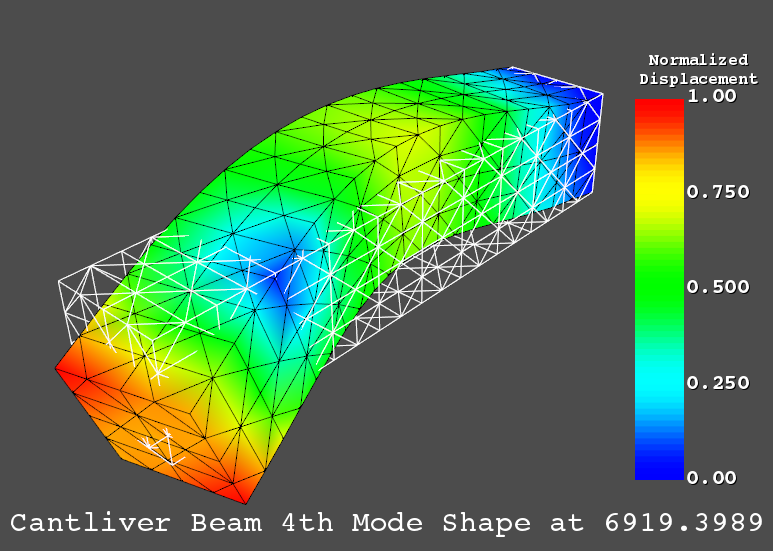Working with a MAPDL Full File (full)#
The MAPDL full file is a FORTRAN formatted binary file containing the mass and stiffness from an Ansys analysis. Using pyansys it can be loaded into memory as either a sparse or full matrix.
Reading a Full File#
This example reads in the mass and stiffness matrices associated with
the above example. load_km sorts degrees of freedom such that the
nodes are ordered from minimum to maximum, and each degree of freedom
(i.e. X, Y, Z), are sorted within each node. The matrices k and
m are sparse by default, but if scipy is not installed, or if
the optional parameter as_sparse=False then they will be full
numpy arrays.
By default load_km outputs the upper triangle of both matrices.
The constrained nodes of the analysis can be identified by accessing
fobj.const where the constrained degrees of freedom are True and
all others are False. This corresponds to the degrees of reference in
dof_ref.
By default dof_ref is unsorted. To sort these values, set
sort==True. It is enabled for this example to allow for plotting
of the values later on.
from ansys.mapdl import reader as pymapdl_reader
from ansys.mapdl.reader import examples
# Create result reader object and read in full file
full = pymapdl_reader.read_binary(examples.fullfile)
dof_ref, k, m = full.load_km(sort=True)
ANSYS only stores the upper triangular matrix in the full file. To create the full matrix:
k += sparse.triu(k, 1).T
m += sparse.triu(m, 1).T
If you have scipy installed, you can solve solve for the natural
frequencies and mode shapes of a system.
import numpy as np
from scipy.sparse import linalg
# condition the k matrix
# to avoid getting the "Factor is exactly singular" error
k += sparse.diags(np.random.random(k.shape[0])/1E20, shape=k.shape)
# Solve
w, v = linalg.eigsh(k, k=20, M=m, sigma=10000)
# System natural frequencies
f = (np.real(w))**0.5/(2*np.pi)
print('First four natural frequencies')
for i in range(4):
print('{:.3f} Hz'.format(f[i]))
First four natural frequencies
1283.200 Hz
1283.200 Hz
5781.975 Hz
6919.399 Hz
Plotting a Mode Shape#
You can also plot the mode shape of this finite element model. Since the constrained degrees of freedom have been removed from the solution, you have to account for these when displaying the displacement.
import pyvista as pv
# Get the 4th mode shape
full_mode_shape = v[:, 3] # x, y, z displacement for each node
# reshape and compute the normalized displacement
disp = full_mode_shape.reshape((-1, 3))
n = (disp*disp).sum(1)**0.5
n /= n.max() # normalize
# load an archive file and create a vtk unstructured grid
archive = pymapdl_reader.Archive(examples.hexarchivefile)
grid = archive.parse_vtk()
# plot the normalized displacement
# grid.plot(scalars=n)
# Fancy plot the displacement
pl = pv.Plotter()
# add the nominal mesh
pl.add_mesh(grid, style='wireframe')
# copy the mesh and displace it
new_grid = grid.copy()
new_grid.points += disp/80
pl.add_mesh(new_grid, scalars=n, stitle='Normalized\nDisplacement',
flipscalars=True)
pl.add_text('Cantliver Beam 4th Mode Shape at {:.4f}'.format(f[3]),
fontsize=30)
pl.plot()

This example is built into pyansys-mapdl and can be run from
examples.solve_km().
FullFile Object Methods#
- class ansys.mapdl.reader.full.FullFile(filename: str | Path)#
Stores the results of an ANSYS full file.
- Parameters:
filename (str) – Filename of the full file to read.
Examples
>>> from ansys.mapdl import reader as pymapdl_reader >>> full = pymapdl_reader.read_binary('file.rst') >>> print(full) PyMAPDL-Reader : MAPDL Full File Title : Demo Version : 20.1 Platform : WINDOWS x64 Jobname : file Matrices : 2 Equations : 345 Nodes : 115 Degrees of Freedom : 3
- property const#
Constrained DOF Returns the node number and DOF constrained in ANSYS.
Examples
>>> full.const array([], shape=(0, 2), dtype=int32)
- property dof_ref#
Sorted degree of freedom reference.
Examples
>>> full.dof_ref array([[ 1, 0], [ 1, 1], [ 1, 2], [115, 0], [115, 1], [115, 2]], dtype=int32)
Notes
Obtain the unsorted degree of freedom reference with >>> dof_ref, k, m = sparse_full.load_km(sort=False)
- property filename#
String form of the filename. This property is read-only.
- property k#
Stiffness Matrix corresponding to sorted DOF.
Examples
>>> from ansys.mapdl import reader as pymapdl_reader >>> full = pymapdl_reader.read_binary('file.rst') >>> print(full.k) <345x345 sparse matrix of type '<class 'numpy.float64'>' with 7002 stored elements in Compressed Sparse Column format>
- load_km(as_sparse=True, sort=False)#
Load and construct mass and stiffness matrices from an ANSYS full file.
- Parameters:
- Returns:
dof_ref ((n x 2) np.int32 array) – This array contains the node and degree corresponding to each row and column in the mass and stiffness matrices. In a 3 DOF analysis the dof integers will correspond to: 0 - x 1 - y 2 - z Sort these values by node number and DOF by enabling the sort parameter.
k ((n x n) np.float_ or scipy.csc array) – Stiffness array
m ((n x n) np.float_ or scipy.csc array) – Mass array
Examples
>>> dof_ref, k, m = full.load_km() >>> print(k) (0, 0) 163408119.6581276 (0, 1) 0.0423270 (1, 1) 163408119.6581276 : : (342, 344) 6590544.8717949 (343, 344) -6590544.8717950 (344, 344) 20426014.9572689
Notes
Constrained entries are removed from the mass and stiffness matrices.
Constrained DOF can be accessed from
const, which returns the node number and DOF constrained in ANSYS.
- property load_vector#
The load vector
Examples
>>> full.load_vector array([0., 0., 0., ..., 0., 0., 0.])
- property m#
Mass Matrix corresponding to sorted DOF.
Examples
>>> full.m <345x345 sparse matrix of type '<class 'numpy.float64'>' with 2883 stored elements in Compressed Sparse Column format>
- property neqn#
Number of equations
Examples
>>> full.neqn 963
- property pathlib_filename#
Return the
pathlib.Pathversion of the filename. This property can not be set.

